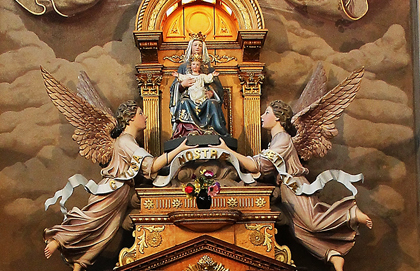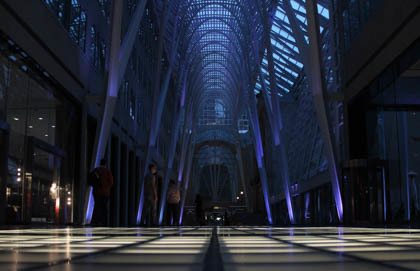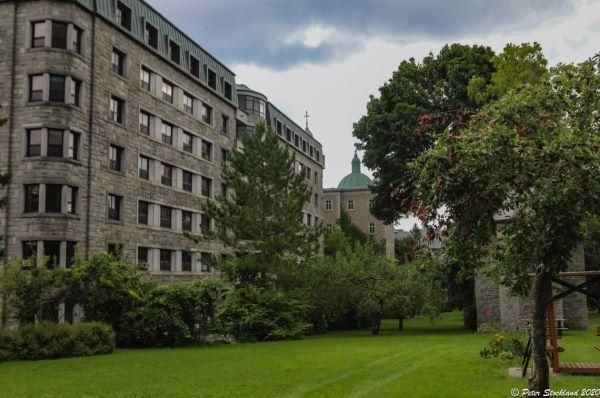Nothing from its humpy stone exterior prepares you for the baroque splendour inside the 150-year-old Church of the Gesù in Montreal. The church is downtown, on René Lévesque Boulevard, one block east of Saint Patrick’s Basilica, but the building’s nondescript architectural symmetry, hidden in part by a high stone wall, makes it easy to ignore. The Gesù’s main doors are four metres above street level, and the marquees between the ascending spiral staircases suggest that it is a theatre, which, in fact, it also happens to be.
The basement was converted into an auditorium in 1923, and the space is recognized as the birthplace of professional French-language theatre in Montreal. Troupes such as the Anciens du Gesù, the Théâtre du Rideau Vert and the Théâtre du Nouveau Monde staged their first productions there.
The careers of Jean Gascon, Jean-Louis Roux and Gratien Gélinas were nurtured at the Gesù. Perhaps because of its proximity to Place des Arts and Montreal’s arts district, the rector, Rev. Daniel LeBlond, a former filmmaker and professional photographer, opened the church to the community in 1995 as a creative arts centre.
Thanks to LeBlond’s efforts, the Gesù has become a sanctuary for what Université de Montréal theology professor Solange Lefebvre calls a community of “fragile Catholics”—a place of worship for those who have distanced themselves from the Church in Quebec but who accept its spiritual teachings. The Gesù, she writes, “is both a place of remembrance and a place where things are forgotten.”
Father LeBlond, who is also a former provincial of the French-speaking Jesuit province in Canada, is also a professional artist who painted the contemporary frontal for the main altar.
“I have always been marginal, and when I became a Jesuit, I became even more marginal,” he says. “If you are marginal, you have two choices: you can isolate yourself or you can build bridges and help transform society.”
He admits there is a certain tension that exists between the Gesù’s religious heritage and its evolution as an arts centre. “Art is not religion, but art and religion are not opposites, they complement each other,” he says. “Lots of artists work in the church. We are for some reason seeing a lot of dancers come to the Gesù.”
The Church, he continues, has a role to play to encourage people to interact with God through art, with the understanding that “historically, many of the great artists made their way through the Church.”
He concedes that a controversial exhibition mounted recently in the eight lateral chapels dismayed some Catholic traditionalists. Among the works were a few nudes in blindfolds, and the Passion of Christ was interpreted in 15 stations instead of 14. (The 15th was the resurrection.) In spite of the outrage, the exhibition was hugely successful in attracting individuals who returned to the church to pray and meditate.
“The Gesù is a place where people who live and work downtown can audaciously celebrate sacred silence,” LeBlond says. “We all need time to reflect, time to take a step back and distance ourselves from this electronic age. Making art also allows you to do that, to take a step back and discover what is in you.
“Artists are at the forefront of social justice, which is also spirituality at work. You learn through art. To be an artist is to get in touch with your inner depths and develop a particular vision of the universe, of what it means to be human.”
The Gesù was built in 1865 as a college chapel 30 years before Montreal had a proper Roman Catholic cathedral. To understand why, it is necessary to understand 19th century ecclesiastical politics in Quebec. Following the conquest in 1763, the Jesuits who had been in New France for 150 years were expelled from British North America and their estates seized by the Crown. The Sulpicians, meanwhile, owned the Island of Montreal and were allowed by the British to keep their seigneurial rights. Tension arose in 1819 when Quebec appointed Jean-Jacques Lartigue as Montreal’s auxiliary bishop. The Sulpicians resented the unilateral appointment and refused to allow Lartigue to use their Church of Notre Dame as a Cathedral. This unleashed a schism between the Sulpicians and the diocesan bishops that went on at the parish level for years.
The Sulpicians, who were compensated by the British for their land after the conquest, had the financial resources to dominate the religious and educational needs of both French- and English-speaking Catholics in Montreal. For the most part, they ignored directives from the diocese. A Cathedral and episcopal palace were eventually built, but they burned in 1852, and the diocese could not afford to replace the buildings.
In order to consolidate his episcopal authority and wrest control of his diocese from the Sulpicians, Lartigue’s successor, Bishop Ignace Bourget invited the Jesuits to return to Montreal in 1842 to open a school that would rival Collège de Montréal, which the Sulpicians had run since 1767. Six priests, led by Félix Martin, and 23 brothers arrived from France. But because of jurisdictional wrangling, it took another six years before they were finally able to open Collège Sainte-Marie.
Bourget then launched a public appeal for funds to build the promised college chapel that would be a copy of Chiesa del Santissimo Nome di Gesù, the Jesuits’ mother church in Rome. He wanted it to be as big, if not bigger than, both Notre Dame and Saint Patrick’s, both landmarks that were built and run by the Sulpicians.
The fundraising appeal failed, and the extravagant plans were scaled back by the Irish-born architect Patrick Keeley, who was hired to design the building. Keeley had just finished the Cathedral of the Immaculate Conception in Albany, N.Y., and was regarded as the in-house east coast architect for the Roman Catholic Church.
During his career, Keeley designed almost every cathedral in New England. On April 6, 1863, Bourget planted a cross where the high altar would be. The following year, the cornerstone was blessed when construction began on March 19, the feast of Saint Joseph. The church opened with a Mass for the college students at dawn on the feast of Saint Francis Xavier on December 3, 1865.
“The ceremony inaugurating the Jesuit’s new church, Bleury, was performed by Mr. [Alexis-Frédéric] Truteau an administrator of the diocese,” reported the Gazette. “The ceremony of blessing was performed privately and at 10:35 the church was filled by a large congregation. It being the commencement of Advent season, the service was simple and an eloquent address was delivered by the Rev. Mr. Bertrand.”
The grandeur of the church is deceptive. The nave appears truncated until you reach the transept, which soars three stories (23 metres) above and opens the church to six magnificent side altars. The space is decorated with grey and gold trompe l’oeil frescoes by 19th century New York decorator Daniel Muller, works inspired by German art that depict scenes from the life of Christ. There are also two massive canvases by an Italian master, Giovanni Gagliardi, which depict Saint Stanislas Kostka and Saint Louis de Gonzaga. A copy of Caravaggio’s Death of Saint Francis Xavier also hangs in the transept.
On either side of one of the side altars, frescoes depict in graphic detail the execution of Saint John de Brito, a Jesuit missionary who was beheaded in India in 1693 and three Jesuits who were crucified in Japan in 1597. A handsome reliquary before the altar contains the remains of three Canadian Jesuit martyrs: Charles Garnier, Gabriel Lalemant and Jean de Brébeuf.
The crowning glory of the decor, however, is underfoot. The parquet floor in the chancel is inlaid with designs of stars, crosses and fleur-de-lys fashioned from seven varieties of wood from local trees. The floor has lost none of its patina after 15 decades of use.
Among the church treasures is a replica of the original statue of Notre Dame de Liesse. The legend surrounding the ornate statue of the Madonna goes back to the Crusades, when three French soldiers were captured and held prisoner in Jerusalem. During their captivity, they prayed to Mary. Overhearing their devotion, a Muslim princess asked the captives to carve an image of Mary—who is mentioned in the Holy Quran more than she is in the New Testament.
The soldiers were not artisans, but were commanded to either come up with a likeness or face execution. They awoke one morning to find the ornate statue in their cell. They were released and took the statue back to France, where it graced the royal chapel. The original was burned during the French Revolution, and the ashes were entrusted to the Jesuits and deposited in the base of a copy that they took to Montreal. A street in Montreal, Notre Dame de Liesse, was named to mark the arrival of the statue.
In 1879, Pope Leo XIII designated the Gesù as the centre of the Canadian Archconfraternity of the Sacred Heart, a worldwide association devoted to making amends through prayer, meditation and good works for the suffering that Christ endured. Mass continues to be celebrated at the Gesù for members every Friday.
In 1960, the Jesuits announced plans to demolish the Gesù and the adjoining Collège to make way for the campus of a planned Catholic university. The Quebec government, however, had embarked on the so-called Quiet Revolution and begun to distance itself from faith-based public institutions. The university was never built, but the Collège Sainte-Marie closed in 1969 and its buildings were torn down in 1976 to make way for a skyscraper, appropriately called Place Félix Martin.
Proceeds from the sale of the property to SNC-Lavalin permitted the Jesuits to restore the Gesù in 1983-84. The church is still not finished, though. Its two bell towers were never completed. That year, Irénée Beaubien, a Jesuit leader in interfaith dialogue, began his Pathways of Faith ministry at the church for divorced Catholics who had remarried.
“Christian faith should be a liberation, not a constraint,” he reasoned long before Pope Francis appeared on the scene. “Some things cannot be preached from the pulpit.”
These days, more cultural events are staged at the church each year than there are Masses. The venue is part of both the International Jazz Festival and the Just for Laughs comedy festival. But the Gesù’s role as a spiritual centre has not been diminished.
“Those who come to Mass seem to want to avoid crowds,” said one priest, “The Gesù has become a discreet shrine in the city, a place for introspection and meditation. Many who come to Mass keep their distance, and some leave before communion. But they are here.”
The Gesù was declared a Quebec historic monument in 1975. A history of the church, Le Gesu: 150 ans d’une eglise, was published in January 2015.






